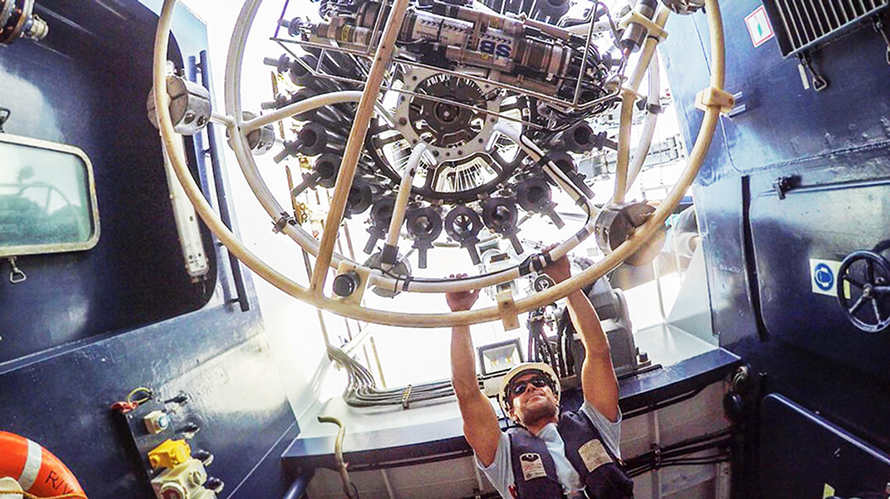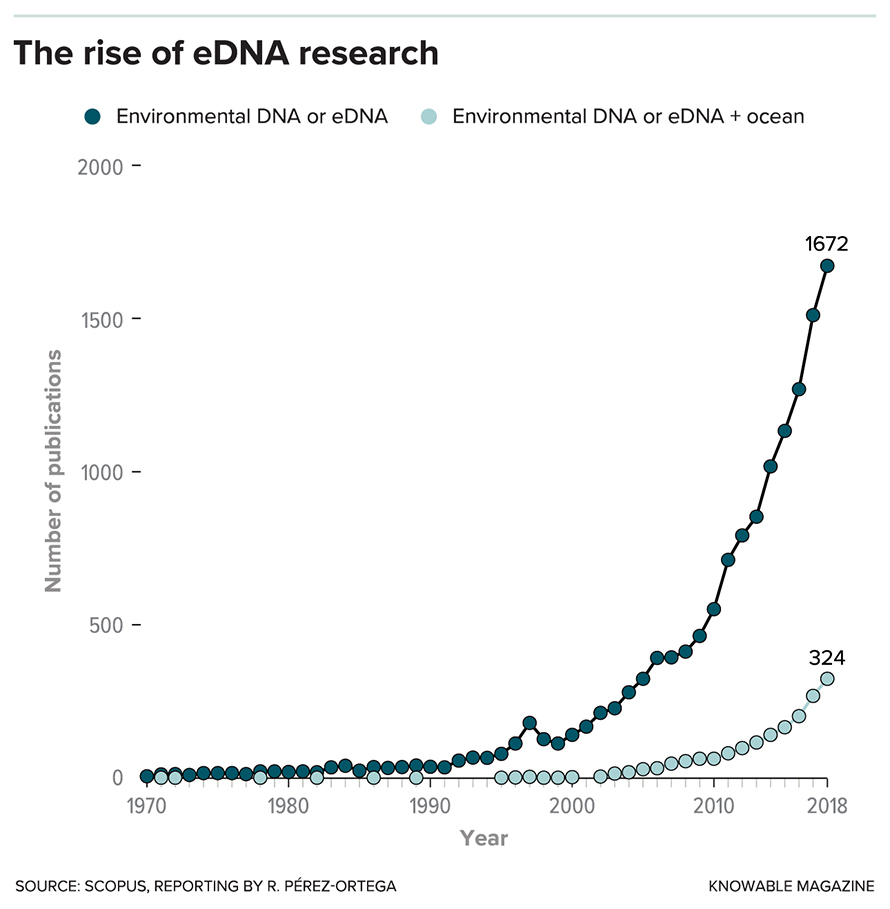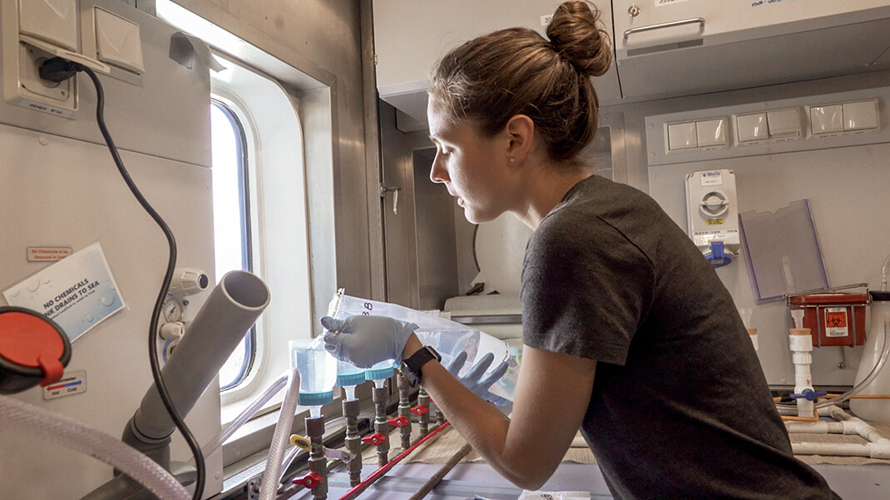A world in a bottle of water
Hilary Starks couldn't wait to get her first three samples of the day. She was standing expectantly on the deck of the 117-foot research vessel Western Flyer in 2015, searching the waters of California's Monterey Bay below. The winch on deck started moving as pulleys and wires slowly lifted what she was waiting for: a five-foot submersible carrying large plastic bottles full of seawater.
Starks, then a lab technician at Stanford University, knew that there were myriad bits of genetic information floating in the one-liter bottles, hidden to human eyes. And modern DNA-deciphering machines would later reveal secrets about the ecosystem the Western Flyer was sailing over.
Monterey Bay is home to hundreds of species of marine animals, but scientists are still far from knowing exactly how many of each there are, or how they move and interact with each other. Now researchers are analyzing the tiny traces of DNA that animals leave behind in the environment, to study their numbers and locations in a noninvasive way.

Modern gene-sequencing technologies have advanced so much that the analysis of such environmental DNA, or eDNA, from small samples of water or soil could revolutionize the way scientists understand ecology and conservation in ecosystems all over the world. "It's really remarkable that in the twenty-first century we're still not able to say exactly what lives in the ocean," says Barbara Block, a marine scientist at Stanford who has been monitoring fish in the Pacific and Atlantic for decades. But today, just a liter of ocean water, housing millions of genetic sequences, can tell many tales about the ecological history of a place.
As ocean acidification and climate change become the new reality, scientists wonder what will happen to the distribution and well-being of plants and animals. "Monitoring communities and ecosystems is going to be much easier done by DNA methods," says Elizabeth Andruszkiewicz Allan, an environmental engineer at Woods Hole Oceanographic Institution in Massachusetts who analyzed Stark's samples while at Stanford. "You take one water sample and look for everything from microbes to whales."
Just as we constantly shed DNA-containing dead cells, creatures in the oceans — from bacteria up to hulking blue whales — leave invisible environmental signs of their presence. Today's sequencing tools are so powerful that researchers can now detect these minute traces of DNA spread out in the environment and, with refined computational methods, figure out what creatures they came from.
Finding the obvious and the elusive
To use eDNA to track species, scientists first multiply, then read, the segments found in a sample. Then they match them to known DNA sequences from species of interest.
In a study in 2012, for example, Philip Francis Thomsen, then at the Natural History Museum of Denmark and now at the University of Aarhus, and his colleagues collected seawater from sites around the Baltic Sea. They detected eDNA from harbor porpoises and long-finned pilot whales, the latter a species rarely seen in the Baltic — showing that the technology had the potential to "find" elusive species.
And last year, researchers in Alaska tracked the abundance of spawning salmon in a small stream by analyzing salmon DNA in the water, finding that it's possible to use eDNA to estimate the abundance of a single species at a specific place even in flowing waters.
Sometimes, scientists use a version of the technique known as metabarcoding to assess DNA from whole groups of organisms, providing a broader snapshot of the biodiversity in a spot in the ocean. This has three key advantages compared to traditional ways of surveying biodiversity: It's highly sensitive, it's cheaper, and it's noninvasive.
"So often, you have to kill whatever you're interested in to collect it," says Starks, who uses eDNA sequencing at her job at the consulting company Cramer Fish Sciences. "It's nice to be able to not have to do that."
Diving in
Use of eDNA analysis in the ocean got its start in the late 1980s, when scientists began looking at DNA in microbial blooms. Now scientists all over the world are studying all kinds of creatures and ecosystems to learn about the complexities of marine communities.
Thomsen, for instance, has used eDNA to study whale sharks in the Arabian Gulf and fish ecology deep off the coast of Greenland. Scientists in Southern California have detected white sharks with eDNA. Researchers in Alaska have studied the harbor porpoise, elusive in those waters. Australian scientists recently were able to detect signals from all of life's major groups in that nation's Coral Bay using eDNA methodology.
"I think it will have a big impact on our understanding of not only the dynamics of communities, but also the presence and absence of species," says Melania Cristescu, an ecological genomicist at McGill University in Canada, whose work focuses on eDNA in freshwater environments. "That is what excites me."

Researchers in Monterey Bay started studying the eDNA of the animals that live in the area six years back, when Ryan Kelly, then a researcher at Stanford's Center for Ocean Solutions, set out to compare eDNA sampling to traditional biodiversity surveys. Kelly wondered whether analyzing eDNA would be an accurate as well as a faster and easier method than having divers physically count animals underwater.
He knew that DNA degrades fast in the ocean, so he first wanted to test just how reliable and sensitive eDNA technology could be. To that end, he started his work in a controlled setting at the Monterey Bay Aquarium, where the 4.5-million-liter Open Sea Tank hosts 12 species of animals, including Pacific sardines, mackerel and sea turtles.
"Here we have a known community — we can see the fish in the tank," Kelly remembers thinking. "If we take a liter of water out of this, can we see the genetics of the DNA of the fish that are in there?"
His team collected water samples from the tank and tested the eDNA. Not only did the team detect the eDNA of most of the bony fish groups resident in the tank, but the method also pinpointed the DNA from the food species fed to those animals.
Beyond what divers can see
Kelly next wanted to look at eDNA in the ocean. He worried that eDNA in seawater could be carried long distances by currents and that samples might therefore not represent the actual biodiversity of a site. So in 2013, he and his team put this concern to the test in the well-studied waters off Pacific Grove, a city northwest of Monterey. Alongside the eDNA work, divers also recorded the vertebrate species they saw at the sample sites, including rockfish, wrasses, surfperch and seals.
The divers spotted 12 types of fishes and marine mammals; the eDNA technique detected 11 of these. But the genetic analysis also revealed 18 additional fishes, mammals and birds that the visual surveys missed even though the animals are known to live there. Kelly's team also found that eDNA analysis could distinguish between habitats as close as 60 meters apart. Following this work, marine biologist Collin Closek, also at the Center for Ocean Solutions, similarly found that eDNA from untested Monterey Bay water samples matched visual observations of anchovies and humpback whales recorded at the same time.
In other words, "eDNA doesn't just move everywhere; it doesn't just swash around the ocean," says Kelly, now at the University of Washington. "It stays in one place. And that was really important to know."
Searching farther and deeper
But researchers so far had only explored the waters near shore. That's why, in September of 2015, Starks set out on the Western Flyer to discover what underwater secrets eDNA could reveal much farther out, in the open ocean.
As the bottle-laden submersible came up from deep waters, Starks poured the seawater samples through tiny plastic filters to capture all the floating genetic material. Then she placed the filters in a –80°C shipboard freezer so that the DNA would stay intact until Andruszkiewicz Allan could analyze it in the lab. For two days, the Western Flyer roamed the ocean while a sleep-deprived Starks worked around the clock to pull 63 more samples up from all over Monterey Bay.
The lab analysis revealed eDNA from 72 fish and mammal species, including sharks, herring, lanternfish and sunfish. Some were deep-living denizens that scientists hadn't previously known inhabited Monterey Bay, such as long-bodied wrymouths, also known as ghostfish.
Researchers in the area aim to learn still more from eDNA. Scientists at the Monterey Bay Aquarium Research Institute have used submersible robots to automate the collection of water samples from the bay. Andruszkiewicz Allan is working on a project to model how eDNA moves in the ocean so that one could know where and when an animal shed the genetic material originally.

Stanford's Block, who has been tagging white sharks along the Pacific coast for years, is using eDNA to estimate their abundance — and, in the lab, trying to develop a test to detect the sex and reproductive status of bluefin tuna in the bay. "I think it's important to have a new technology other than a fishnet to assess who's there," she says.
Enhanced fish-finding
Environmental DNA could also help monitor fish populations every year. Various species of salmon used to swim in the Monterey Bay region, says Closek, but they're rare now, and scientists would like to know where they are and if they're returning. Use of eDNA could track those species and determine if they are coming back to locations they historically inhabited.
Researchers are also eager to learn more about whales. Humpbacks were aggressively hunted in the Pacific during the 1800s and early 1900s and their population, once 15,000 strong, dropped to 1,200 by 1966. Since receiving federal protection a half-century ago, their numbers have been rising, reaching at least 18,000 in recent years. "Our understanding of where those whales are located can be further improved by being able to have these eDNA locations," says Closek.
Scientists also hope that these studies can inform policy decisions through detection of hard-to-distinguish and endangered species in a location, or invasive species that threaten native wildlife. The US Fish and Wildlife Service has used eDNA since 2013 to monitor for two invasive Asian carp species in and around the Great Lakes, for example. "eDNA provides the here-and-now view of the living world that policy decisions demand," wrote eleven researchers, including Kelly and Thomsen, in a 2014 paper in Science.
Not so fast
Environmental DNA methods have their drawbacks. Every step from sample collection to results can go wrong: "You have to be very clean," Cristescu says. Very few labs, she adds, have the cleanliness standards needed for eDNA work, so the chances of "finding" species that are not actually present is high. And despite the sensitivity, it's also possible to miss species that are there if the amount of eDNA is too scant or too degraded, or if a key step in the technique is not performed correctly.
Environmental DNA also cannot yet reveal information on the sex or age of individuals of a species, so the technology will probably not replace traditional surveys any time soon. But it can certainly complement them. "This is just a different net" for catching animals, Kelly says.
"It's a new frontier of how we're seeing the world in a really different way," he says. "Who wouldn't want to look into a glass of seawater and see starfish, and orcas, and everything in between?"
Editor's note: The text was amended on August 5, 2019 to add Philip Francis Thomsen's current affiliation with the University of Aarhus.
This article originally appeared in Knowable Magazine, an independent journalistic endeavor from Annual Reviews.
Enjoy reading ASBMB Today?
Become a member to receive the print edition four times a year and the digital edition monthly.
Learn moreGet the latest from ASBMB Today
Enter your email address, and we’ll send you a weekly email with recent articles, interviews and more.
Latest in Science
Science highlights or most popular articles

Fueling healthier aging, connecting metabolism stress and time
Biochemist Melanie McReynolds investigates how metabolism and stress shape the aging process. Her research on NAD+, a molecule central to cellular energy, reveals how maintaining its balance could promote healthier, longer lives.

Mapping proteins, one side chain at a time
Roland Dunbrack Jr. will receive the ASBMB DeLano Award for Computational Biosciences at the ASBMB Annual Meeting, March 7–10, just outside of Washington, D.C.

Exploring the link between lipids and longevity
Meng Wang will present her work on metabolism and aging at the ASBMB Annual Meeting, March 7-10, just outside of Washington, D.C.

Defining a ‘crucial gatekeeper’ of lipid metabolism
George Carman receives the Herbert Tabor Research Award at the ASBMB Annual Meeting, March 7–10, just outside of Washington, D.C.

The science of staying strong
Muscles power every movement, but they also tell the story of aging itself. Scientists are uncovering how strength fades, why some species resist it and what lifestyle and molecular clues could help preserve muscle health for life.

Bacteriophage protein could make queso fresco safer
Researchers characterized the structure and function of PlyP100, a bacteriophage protein that shows promise as a food-safe antimicrobial for preventing Listeria monocytogenes growth in fresh cheeses.

